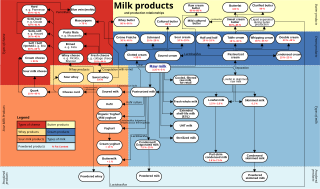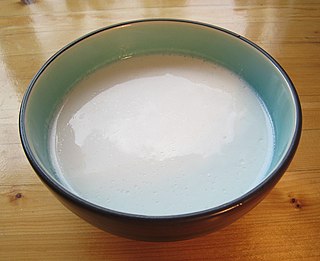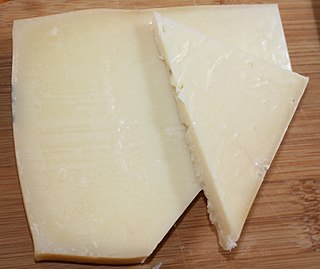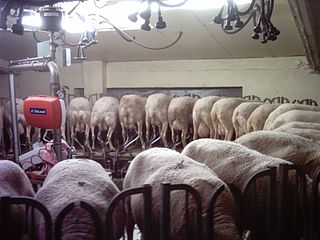
Dairy products or milk products, also known as lacticinia, are food products made from milk. The most common dairy animals are cow, water buffalo, nanny goat, and ewe. Dairy products include common grocery store food around the world such as yogurt, cheese, milk and butter. A facility that produces dairy products is a dairy. Dairy products are consumed worldwide to varying degrees. Some people avoid some or all dairy products because of lactose intolerance, veganism, environmental concerns, other health reasons or beliefs.

Halloumi or haloumi is a cheese of East Mediterranean origin made from a mixture of goat's and sheep's milk, and sometimes also cow's milk. Its texture is described as squeaky. It has a high melting point and so can easily be fried or grilled, a property that makes it a popular meat substitute. Rennet is used to curdle the milk in halloumi production, although no acid-producing bacteria are used in its preparation.

Cottage cheese is a curdled milk product with a mild flavour and a creamy, heterogeneous, soupy texture, made from skimmed milk. An essential step in the manufacturing process distinguishing cottage cheese from other fresh cheeses is the addition of a "dressing" to the curd grains, usually cream, which is mainly responsible for the taste of the product. Cottage cheese is not aged.

Curd is obtained by coagulating milk in a sequential process called curdling. It can be a final dairy product or the first stage in cheesemaking. The coagulation can be caused by adding rennet, a culture, or any edible acidic substance such as lemon juice or vinegar, and then allowing it to coagulate. The increased acidity causes the milk proteins (casein) to tangle into solid masses, or curds. Milk that has been left to sour will also naturally produce curds, and sour milk cheeses are produced this way.

Goat cheese, goat's cheese or chèvre is cheese made from goat's milk. Goats were among the first animals to be domesticated for producing food. Goat cheese is made around the world with a variety of recipes, giving many different styles of cheeses, from fresh and soft to aged and hard.

Kashkaval is a type of cheese made from the milk of cow's, sheep's, goat's or mixture thereof. In Albania, Bulgaria, Kosovo, North Macedonia, Romania and Serbia, the term is often used to refer to all yellow cheeses. In English-language menus in Bulgaria, kashkaval is translated as 'yellow cheese'.

Coconut milk is an opaque, milky-white liquid extracted from the grated pulp of mature coconuts. The opacity and rich taste of coconut milk are due to its high oil content, most of which is saturated fat. Coconut milk is a traditional food ingredient used in Southeast Asia, Oceania, South Asia, and East Africa. It is also used for cooking in the Caribbean, tropical Latin America, and West Africa, where coconuts were introduced during the colonial era.

Paneer, also known as panir, is a fresh acid-set cheese common in the cuisine of the Indian subcontinent made from full-fat buffalo milk or cow milk. It is a non-aged, non-melting soft cheese made by curdling milk with a fruit- or vegetable-derived acid, such as lemon juice.

South African cuisine reflects the diverse range of culinary traditions embodied by the various communities that inhabit the country. Among the indigenous peoples of South Africa, the Khoisan foraged over 300 species of edible food plants, such as the rooibos shrub legume, whose culinary value continues to exert a salient influence on South African cuisine. Subsequent encounters with Bantu pastoralists facilitated the emergence of cultivated crops and domestic cattle, which supplemented traditional Khoisan techniques of meat preservation. In addition, Bantu-speaking communities forged an extensive repertoire of culinary ingredients and dishes, many of which are still consumed today in traditional settlements and urban entrepôts alike.

Kefalotyri or kefalotiri is a hard, salty white cheese made from sheep milk or goat's milk in Greece and Cyprus. A similar cheese Kefalograviera, also made from sheep or goat milk, is sometimes sold outside Greece and Cyprus as Kefalotyri. Depending on the mixture of milk used in the process the color can vary between yellow and white.
Crowdie is a type of soft, fresh cheese made from cows' milk, traditionally from Scotland.
Jibneh Arabieh is a soft white cheese found all over the Middle East. It is particularly popular in the Persian Gulf region. The cheese has a mild taste similar to feta but less salty. The heritage of the product started with Bedouins using goat or sheep milk; however, current practice is to use cow's milk to make the cheese. Jibneh Arabieh is used for cooking, or simply as a table cheese.

Cheese is a dairy product produced in a range of flavors, textures, and forms by coagulation of the milk protein casein. It comprises proteins and fat from milk. During production, milk is usually acidified and either the enzymes of rennet or bacterial enzymes with similar activity are added to cause the casein to coagulate. The solid curds are then separated from the liquid whey and pressed into finished cheese. Some cheeses have aromatic molds on the rind, the outer layer, or throughout.

Sheep's milk is the milk of domestic sheep. It is commonly used to make cultured dairy products, such as cheese. Some of the most popular sheep cheeses include feta (Greece), ricotta (Italy), Roquefort (France) and Oscypek (Poland).

Rushan is a cow's milk cheese of Yunnan, China. It is traditionally made by the Bai people, who call it nvxseiz, the etymology of which is unclear.

The production of cheese predates recorded history, beginning well over 7,000 years ago. Humans likely developed cheese and other dairy foods by accident, as a result of storing and transporting milk in bladders made of ruminants' stomachs, as their inherent supply of rennet would encourage curdling. There is no conclusive evidence indicating where cheese-making originated, possibly Europe, or Central Asia, the Middle East, or the Sahara.
Lighvan is a sour, hole filled brined curd cheese traditionally made from sheep's milk in Liqvan, a village in East Azerbaijan, Iran.













